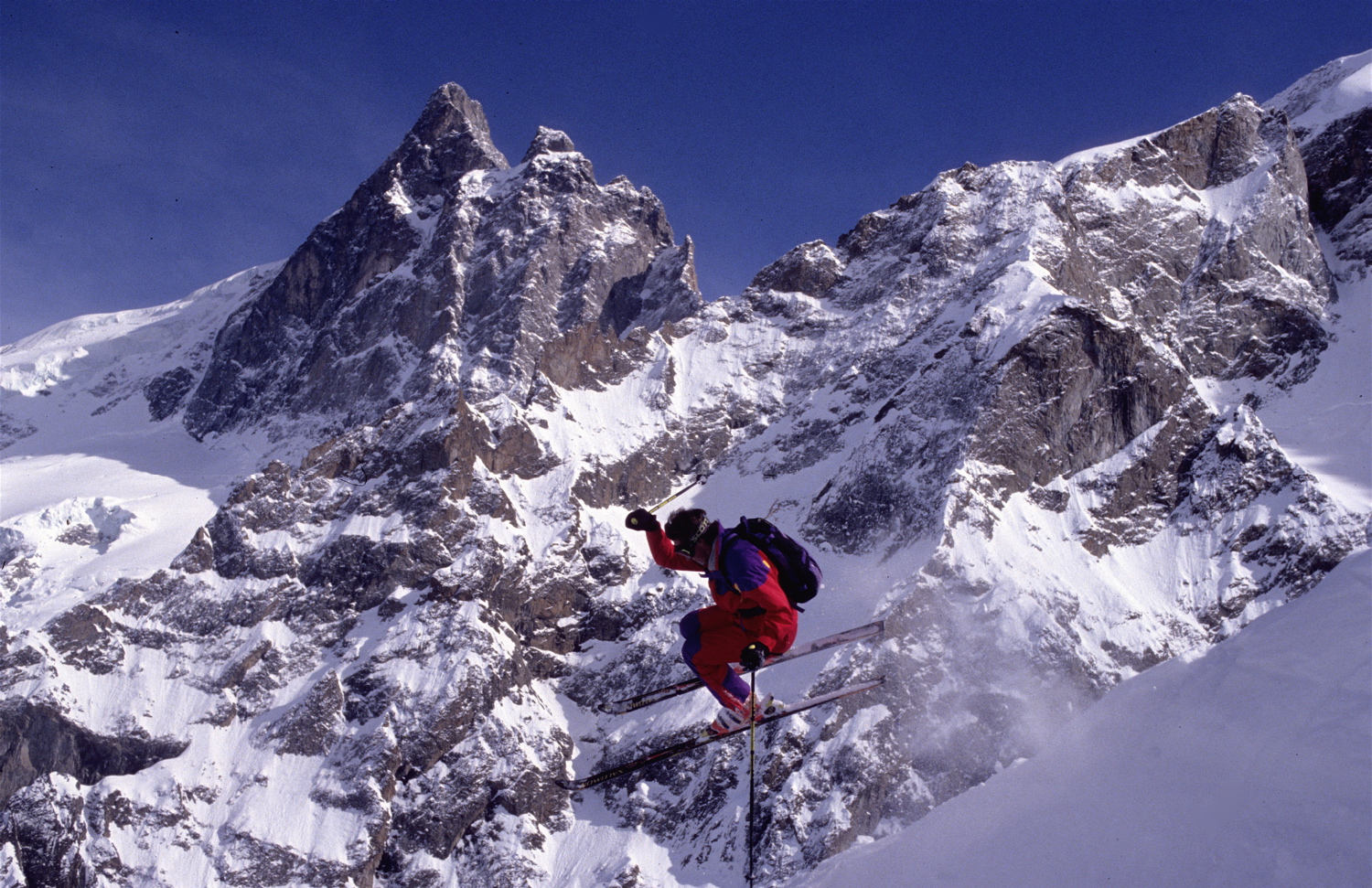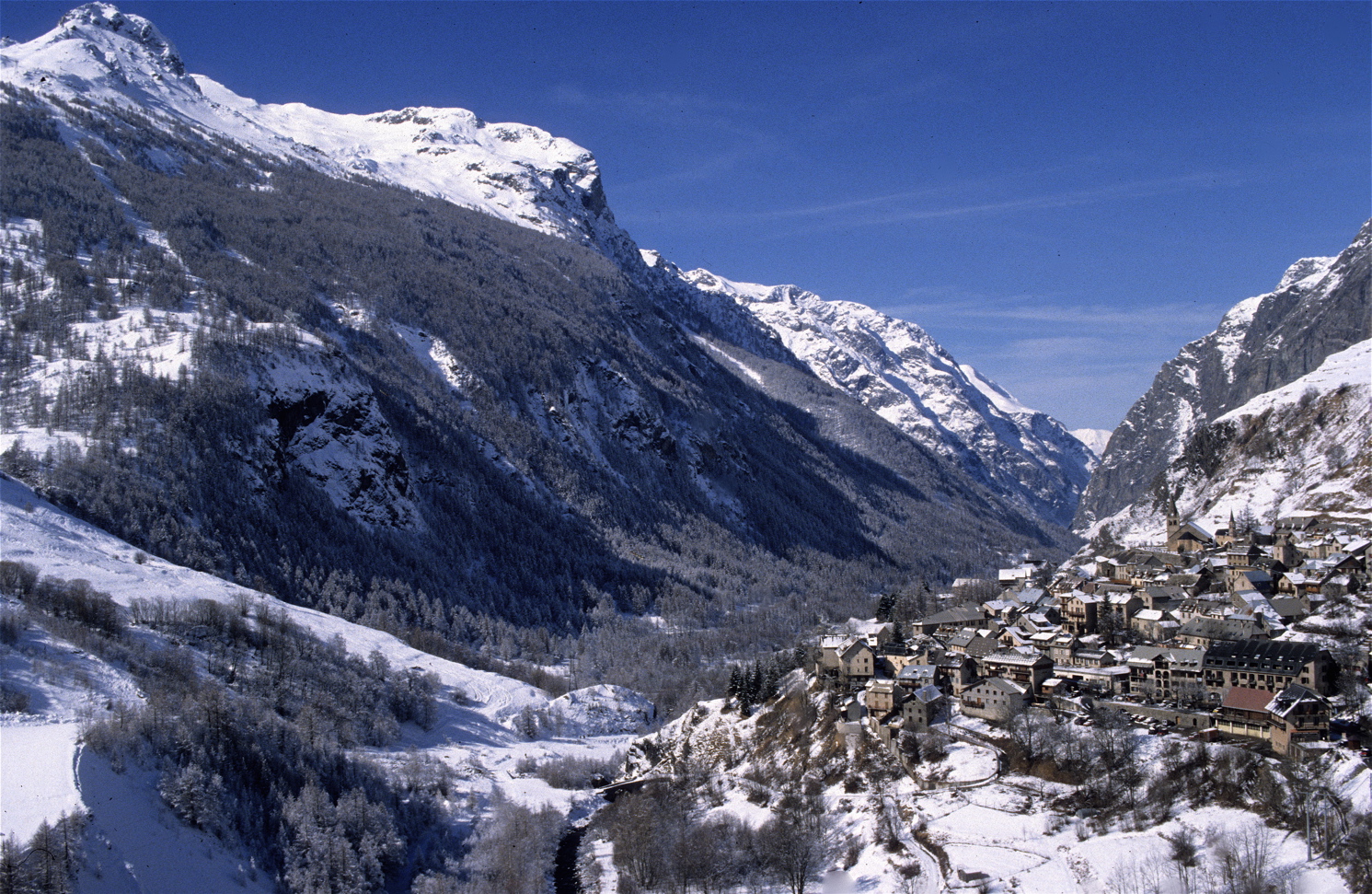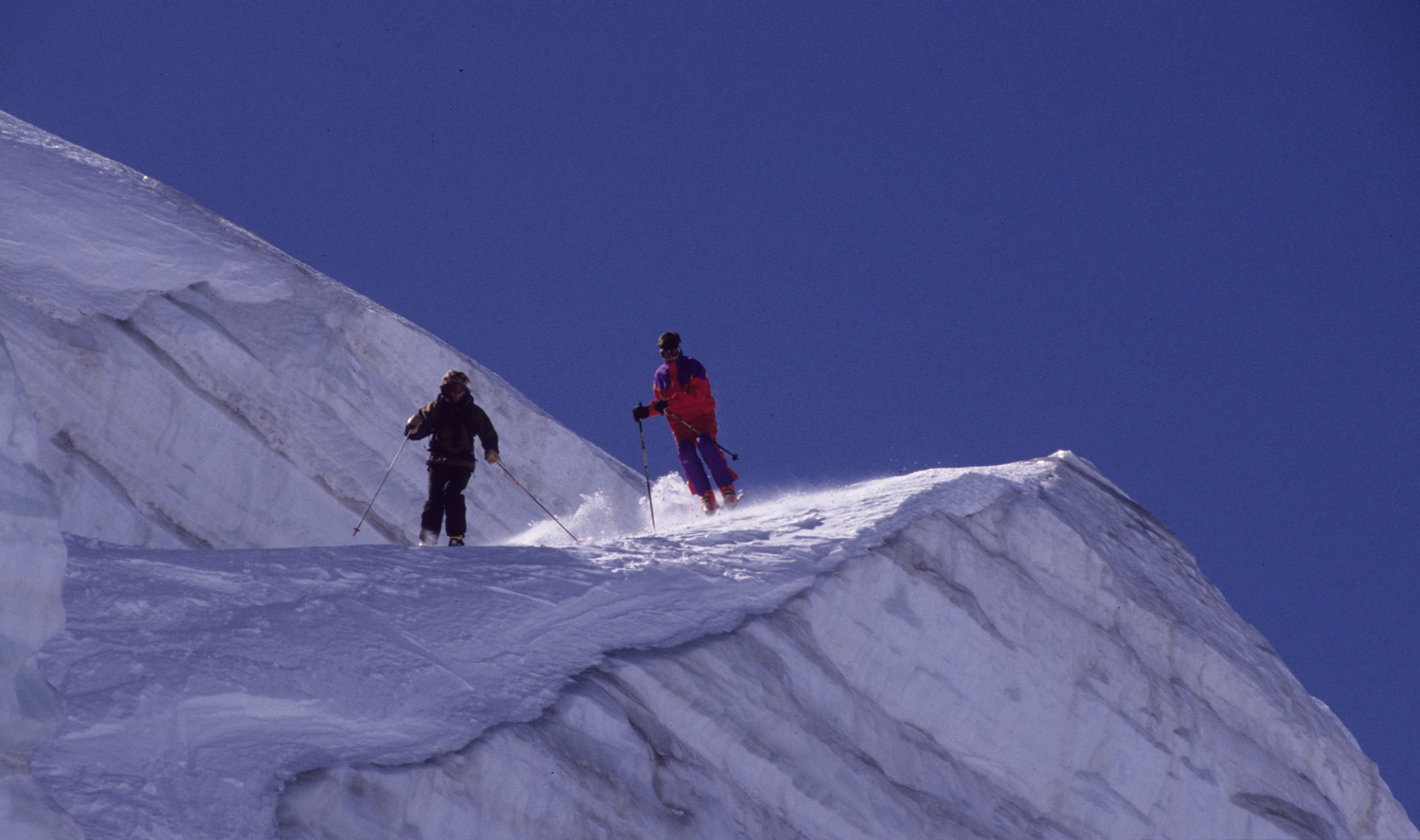La Grave, France: La Meije
“I have been wakened in ski resorts by everything from monastery bells to snow plows. A chicken, however, is a first.”
La Chaumine
Skiers, La Meije
“More than the slides, however, it is La Grave’s extreme, unpatrolled terrain that discourages all but the crampon and guide pack crowd.”
SKIER, La Meije
“The rooster crowed again and unable to sleep, I opened the window and studied Le Meije’s sheer north face.”
Tram, La Grave
“As such they regard any publicity as a catastrophe. Bill tells me the best thing that could happen to La Grave is for the road to be blocked by an avalanche.”
Exit from GIROSE
Chutes La Grave
“On a busy day, a hundred skiers will cross from Les Deux Alpes simply to ski the Vallon or Col du Lac–by La Grave’s standards basic intermediate runs.”
Sign On La Meije
Piste To Les Deux Alpes
Gary Ashurst, Les Deux Alpes
Hotel Le Chaumine
Ventelon, 05320
La Grave, France.
Tel : 00 33 (0)4 76 79 90 28.
www.theskierslodge.com
Grenoble is the closest airport to La Grave is two hours
away by car.
I have been wakened in ski resorts by everything from monastery bells to snow plows. A chicken, however, is a first. Dawn is just brushing La Meije’s 13,064 foot summit above La Grave, France when the rooster’s strident crow fills my room in La Chaumine Skiers Lodge. A moment of cool, blue silence follows before Globo, the sled dog who sleeps on the hotel deck, lifts his muzzle in a low mournful howl.
La Meije
Globo is unhappy. If he could talk, he would petition the Chaumine’s guests to untie the knots, ropes and carabineers that keep him from devouring the tri-colored French cock. And in truth, if the powerful husky wasn’t anchored to the railing, the rooster’s life would be measured in seconds–a fact that makes me give some thought to untying the sad, big boy.
Globo was bred for speed, courage and power and thus is not especially obedient. During the day he sleeps in front of the Chaumine’s bar and though the guests have all been warned about his obsession with chickens, it only takes one person to forget to close the front door and the wolfish Husky is gone.
Englishman Les Harlow, who owns the hotel with Swede Pelle Lange admits “You don’t want to know how much I’ve spent on chickens this year.” Les no longer bothers to argue with the neighboring farmers when they appear holding their tattered, blue ribbon pullets. “They just quote me a figure and I pay it,” he says shaking his head.
Located two and half hours from Grenoble and set on the northern boundary of Frances’ enormous Parc National Des Ecrins, the village of La Grave is so pastoral, it barely rates a circle on a Michelin map. Even the French have trouble placing this tiny resort with its two hotels and single, two stage gondola that accesses big vertical, prodigious snowfalls and virtually no avalanche control.
They also have trouble passing on the precipitous road that skirts the massive ski interconnects of l’Alpe d’Heuz and les Deux Alpes. The road is sheltered by concrete sheds and stoplights to restrict travel when avalanches drain from distant and unseen cirques. In late February, the valley is divided by enormous slugs of dirty snow, splintered trees and apartment sized boulders. More than the slides, however, it is La Grave’s extreme, unpatrolled terrain that discourages all but the crampon and guide pack crowd.
SKIER On POWder, Girose
Less than five hundred people live in La Grave and the five tributary villages of Ventelon, Valforide, Le Chazelet, Les Terrasses and Les Hieres. Arriving from the north, there is no evidence of condos, T-shirt shops, boutiques or fast food. In fact the fastest food in La Grave is the steak and pome frittes advertised on the black board outside Le Rateau Restaurant. La Grave’s pastoral pace can be found in Chez Marcel’s Glacier Bar where a handful of guides and their clients sip beer, smoke strong cigarettes and study the shadow play on La Meije. It can also be found in La Grave’s bakery, its buchery, lone ski shop, narrow streets and half a dozen stone barns anchored to the steep hillsides. And yet, the only thing that truly sets La Grave apart from a hundred other French mountain villages is its gondola.
In 1986 an ecoterrorist dynamited a pylon which closed the gondola for two years. Locals claim the bombing was a response to La Grave’s growth. Either way, the bomber was never caught and when the lift finally reopened, Les Harlow, who had had been living in Argentierre drove over to see what all fuss was about. Though a run top to bottom usually takes an hour, arriving in the midst of a huge storm he remembers, “It was a two run day. We’d take the gondola to the top and ski untracked powder back to the village.” There were no apartments to rent, but Les heard the La Chaumine was for sale and without quite knowing what he’d gotten into, suddenly owned a hotel.
La Chaumine isn’t really a hotel. Not in a classic sense. Shaped by the personalities of Harlow and Lang it’s more a rambling, three story French farmhouse where the guests are predominantly English and Swedish. At the La Chaumine beacons and guides are issued with your room key, you write down what you take from the bar, and the French cuisine is nothing short of remarkable.
Doctors On GIROSE
The rooster crowed again and unable to sleep, I opened the window and studied Le Meije’s sheer north face. First climbed in 1876 by Pere Gaspard, the brooding peak was the last major summit to be conquered in the Alps. Laced with rocks, glacial ice and vertical snow fields, Le Meije is huge. From a distance La Grave’s two stage gondola move imperceptibly above the low larch forests.
Denis Creissels solved the gondola’s fixed grip loading dilemma by spacing groups of five cabins so that when one was in the base, two were in the middle and another was at the summit. This layout has lead to bizarre, occasionally suicidal behavior such as the skier who jumped between two cabins for a cigarette. Though limited in its uphill capacity, the gondola functions very well, at least until the skiers at the head of the line panic and start throwing their skis onto the leading cabins.
Guide Gary Ashurst and I squeeze into a cabin with American ski bums Bill and Jay who in a previous life were known as the “Crud Brothers.” The two are joined by the goateed Roberto who just dislocated his thumb in a couloir and J.P. an expatriate Telluride local who has been chased while skiing out of bounds by more Colorado ski patrolmen than he cares to remember.
J.P. nonchalantly jams the gondola door with his ski boot to capture the cool morning air. If they catch you, the French lifties go berserk, but as soon as we’re out of the station the door swings open to a six hundred foot free fall to the Glacier de La Meije. Though the boys behave as if they are lounging on a sunny deck in Caans, they are less than happy to hear I am on assignment for an American snow sports magazine. La Grave neither encourages nor discourages off piste, but the chutes and steep faces appeal mightily to the local bums who, in trade for the spectacular terrain, sport patched together ski suits, ski old equipment and live three to a studio apartment.
Ashurst Girose Glacier
As such they regard any publicity as a catastrophe. Bill tells me the best thing that could happen to La Grave is for the road to be blocked by an avalanche. It is Roberto, however, who cuts to the chase. “So what’s your angle,” he inquires. “More of that it’s so great, it’s so rad, you have to ski it to believe it…..shit?”
“You ought to write about the woman who ate it in Tre Fete this morning.” Bill suggests.
“I watched the chopper evacuate her,” Jay interrupts.
Extreme Icon Doug Coombs also fell to his death in the Couloir de Polichinelle on April 5, 2006.
Because there is no ski patrol in La Grave, the injured are expected to limp down under their own power. In life and death emergencies, however, the Gendarmes will heli from Briancon.
Set to one side of the popular Glacier du Vallon, the Tre Fete resembles nothing as much as an icy funnel. Here an intermediate slope leads over a transition that steepens and narrows onto forty-five degree boiler plate that in turn drops vertically to a dangerous right hand dog leg. Winds from the departing storm had polished the entry to a sheer sheet of ice and that morning the woman had blundered far to the right, lost an edge, started to slide then cart wheeled over the rocky dog leg. “On a day like today, just set up at the mouth and you’ll get all the shots of sliders you can use.” Roberto promises.
At breakfast the next morning Ashurst asks if I’m ready for the Glacier de la Girose. Two days before a fast moving storm swept a foot of snow across the Girose’s seven thousand vertical feet of open snow fields and bright blue ice falls. The exit for the Girose descends through a series of steep chutes and Gary cautions that skiers must hack through avalanche debris and ford the Romanche River which, overnight has turned an angry chocolate brown. Our group of six Swedish doctors decide to ski first and worry about the chutes, debris and river later. Shouldering our packs and skis we pile into the Chaumine’s van.
To ski the Girose you must first climb to the Dome de la Lauze ridge. It is not a long climb from La Grave’s upper T-Bar–barely enough to make us break a sweat, but after a two days of freezing temperatures, the building heat has softened the north faces that funnel into the Girose’s lower chutes. For that reason Ashurst wants to get moving before the danger of wet slab avalanches rises.
Les DeuX Alpes
To the west we can see the summit of Les Deux Alpes. On a busy day, a hundred skiers will cross from Les Deux Alpes simply to ski the Vallon or Col du Lac–by La Grave’s standards basic intermediate runs. For that reason alone, it is no secret that Les Deux Alpes covets La Grave’s expert off piste terrain. In fact the larger ski resort would love to throw up a drag lift to connect the two areas but so far the commune de La Grave has resisted its overtures. ashurst-glacier
Caught in a world of deep snow, blue ice and sedimentary rock, the doctors are soon whooping it up. You don’t have to speak Swedish to figure out this one run trades fairly for their thirty hour drive in a Saab. The medicos abandon all pretense, start trading first tracks and the occasional fall until Ashurst stops abruptly above the first chute. Below a sliver of snow squeezes between rock cliffs. This is the lone way down and, jump turning into the mouth, Gary kicks off a small slide that strips the overlying powder off the boiler plate. Taking a look at the dicey, potentially dangerous line, the doctors quit celebrating and consult.
Lit by a low angle sun, and viewed from the gentle Crete de Puy Salie, the Girose stair steps down a series of open, untracked snow fields and hanging blue ice falls. The winter’s heavy snowfall has filled in all but the largest crevasses but Ashurst cautions us to ski in control. The first two hundred vertical feet combines a skiff of powder over wind blown crust. Pointing his skis into the fall line, one of the doctors sits back on his tails and rockets away from the group.
His mistake alarms Ashurst who re-emphasizes caution then leads us out toward a series of wide, gentle bowls. It is huge, untracked terrain and I settle into a first turn and forget about everything but the snow, the scenery and floating from edge to edge. I roll off knolls, search for the softest, deepest snow and avoid the subtle depressions that warn of crevasses. The upper Girose is both immense and deep. After a thousand vertical feet the valley floor appears no closer than before. As we descend the fall line grows steeper and more technical and we are forced to skirt the icy debris that lays scattered across the living glacier.
A few carefully sideslip the first chute until it widens enough to turn. Skirting a towering cliff, we ski a sunny snowfield down to a second chute which leads in turn to another snowfield and another chute. Warmed by the lower altitude, the snow grows softer in the sun and harder in the shadows until we find ourselves jumping down five hundred vertical feet of rock studded boiler plate. No one complains–either then, or picking through the avalanche debris, hiking the forest, or fording the river. And when we eventually reach La Chaumine’s Van which is waiting to take us back to La Grave’s gondola we stare back up at the Girose. From below it seems impossibly steep and we take the least pride in the tracks that divide the sunlit snow fields above.
That night, Gary and I visited Monique Sionne who works as a waitress and house keeper at La Chaumine. Monique lives with her husband Pierre and two sons on a small farm in the adjacent village of La Terrasse. She does not find it odd that, until this year, she had never traveled further than twenty-five kilometers down to Le Bourg D’Oisans. La Grave dates back fifteen hundred years to Roman Times and in reply, she says simply, “The Sionnes have always lived here.”
Pouring Gary and I a glass of Genipi, Pierre tells us the fragrant liquor is distilled from the flower of death. “You must climb among the rocks above 2000 meters to find it, and often you discover there is no way down but to fall,” Pierre shrugs, nodding for us to drain our glasses.
Ashurst, pierre Sionne
Warmed by the Sionne’s country hospitality and Genipi we follow Pierre out to the barn filled with goats and chickens. Listening to his prize cock crow, I ask Gary if Globo had ever raided the Sionne farm. This once, however, he does not translate. And taking his silence as my answer, I sense that in La Grave, questions about dogs and roosters are as weighty as questions about fixed grip gondolas, deep powder, extreme chutes and the chance of finding a job.



